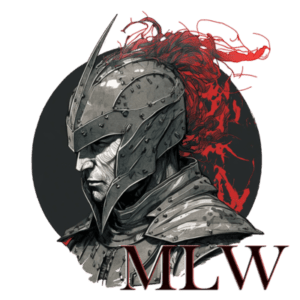Dungeons and Dragons is a tabletop role-playing game that has been captivating the imagination of players for over four decades. At the heart of this game lies a vast bestiary of fantastical creatures, each with its own unique abilities and powers.
From terrifying dragons to towering giants, the creatures of D&D have been responsible for some of the most memorable moments in the game’s history. Each creature has its place and purpose in the story. Some of them are villains, some of them allies, and some of them have no standing.
In this article we’ve decided to take a look at the most powerful creatures players can encounter in the game. We’ll introduce the creature, and talk a little bit about their powers and their background. These creatures can then be used in your own campaigns!
Intellect Devourer (CR 2)

An intellect devourer, or brain dog, is an abomination that takes the form of a disembodied human brain with 4 bestial legs that carry it around. Most, if not all intellect devourers, are servants of mind flayers and are looked upon as dreadful beings in the Underdark.
As the name implies, these beings are capable of magically consuming another humanoid’s brain and absorbing energy from it while leaving the humanoid incapacitated as a result of the extraction. In some cases, the victim’s mentality will be crushed to the point where they’re dazed and unable to act.
As if the creature isn’t horrendous enough as it is, the Intellect Devourer can replace a humanoid’s brain after consuming it, it is then possible for the devourer to control the host body as it if were its own.
Should this happen to one of your party members, you’ll have to fight one of your own, as they’re no longer controlled by themselves.
Pyrolisk (CR 3)

Initially, one doesn’t think much of the Pyrolisk as the creature is depicted as a cockatrice-dragon the size of a chicken with a chicken-like head but as the battle starts, challengers will come to understand that the Pyrolisk is, in fact, one of the most dangerous creatures in Dungeons and Dragons.
They are malevolent creatures that thrive to spread mayhem. Pyrolisks attack most other creatures who come close to them, even unprovoked – but their worst enemies are the phoenixes. They’re considered mortal enemies to one another.
When you shed light on the Pyrolisks attack, you will understand why wreaking havoc and spreading mayhem isn’t difficult for them. The chicken-dragon-cockatrice has multiple abilities that deal lethal damage to its foes.
To their disposal are many attacks, but two stand out. The first one is the pyrolisk’s deadly gaze that sets anyone on the other end of it aflame, killing them unless they succeed in a saving throw or are resistant to fire.
You Might Also Like: The Best D&D One-Shots For New 5E Players
Second to none comes an attack known for being bizarre, it’s the 43-hit dice for a potential of 344 damage when the stars align for the Pyrolisk. Few challengers stand upright after being on the receiving end of this attack.
Black Pudding (CR 4)

Depicted as a structureless mass of tar, the Black Pudding is among the deadliest of the oozes and slimes that roam the underground sewer canals or temples of the world. This pile of goo is made even more lethal by the fact that it’s immune to damage.
Any attempts to damage the black pudding will cause the creature to split into two equally dangerous blobs. The monstrosity deals tremendous amounts of damage with every hit and its attacks penetrate armor with ease, making it suboptimal to allow the creature to multiply even once.
But even the black pudding is designed with a simple flaw that will allow players to deal damage to it without spawning clones, and that’s its weakness to fire spells. This is by no means obvious to anyone challenging the black pudding, which makes it a challenging and rewarding encounter.
Death Slaad (CR 10)
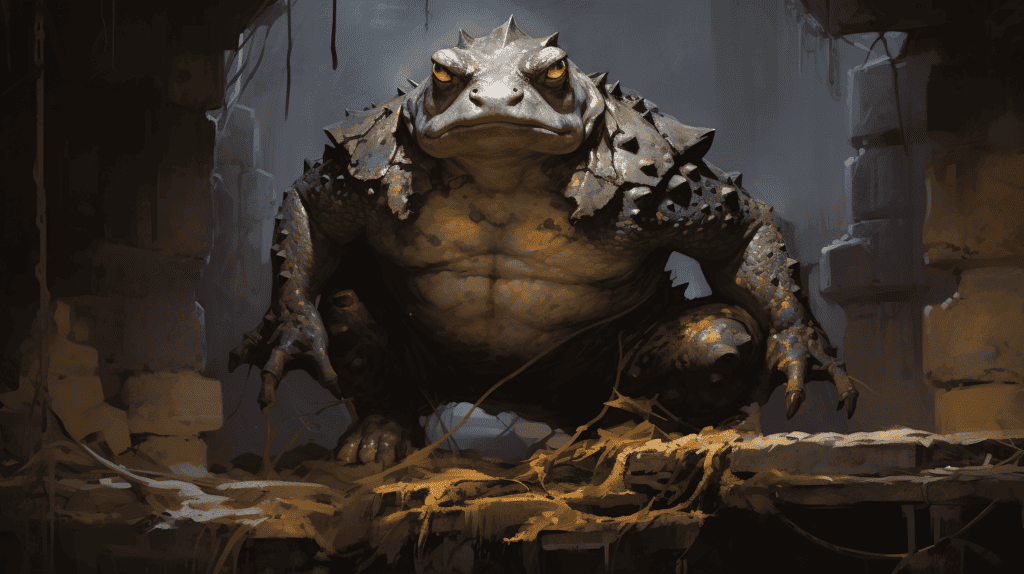
Among the slaad species, which are known for their unpredictable and chaotic nature, the Death Slaad is thought of as the strongest and deadliest. Being the pinnacle of a race that strives to bring evil and chaos to all gives the Death Slaad a lot of power and influence over other Slaad, but also other creatures.
This influence allows the Death Slaad to gather large armies and send them through with the intention of destroying peace and spreading chaos across multiple planes.
Death Slaads are capable of morphing into humanoids to disguise themselves, and even though their appearance transforms from truly monstrous into a persuadingly regular humanoid, they still maintain their true strength, making them incredibly powerful and deceitful.
Resistance to magic and the ability to wield a magic greatsword that deals tremendous damage is part of what makes Death Slaads scary.
Encountering a Death Slaad is not only a test of pure strength and stamina. Rather, the battle will force players to deal with the Slaad’s manipulative and strategic nature along with its intellect and raw force.
Defeating this malevolent creature will require players to use their resourcefulness, but it will make for a memorable triumph.
Aboleth (CR 10)

An eel-like anomaly with malevolent instincts, the Aboleth are a race of aquatic creatures with powerful psionic powers. Formerly, Aboleth were considered gods of the lakes but they were stripped of their status by the true gods, and the Aboleth have sought vengeance ever since.
These amphibians are immense, measuring 6 meters in length and weighing about 3000 kilograms at their prime. They do, however, continue to grow in size as they age, which is why some ancient Aboleth doubles the average size of their kin.
Armed with tentacles, these creatures can swing brutal melee attacks that can inflict a disease upon their victim. They’re even able to enslave it, should the victim fail his or her saving throw.
If a character connects with the Aboleth, telepathically, the monster can learn of the character’s greatest desires and exploit them.
Hecatoncheire (CR 11)
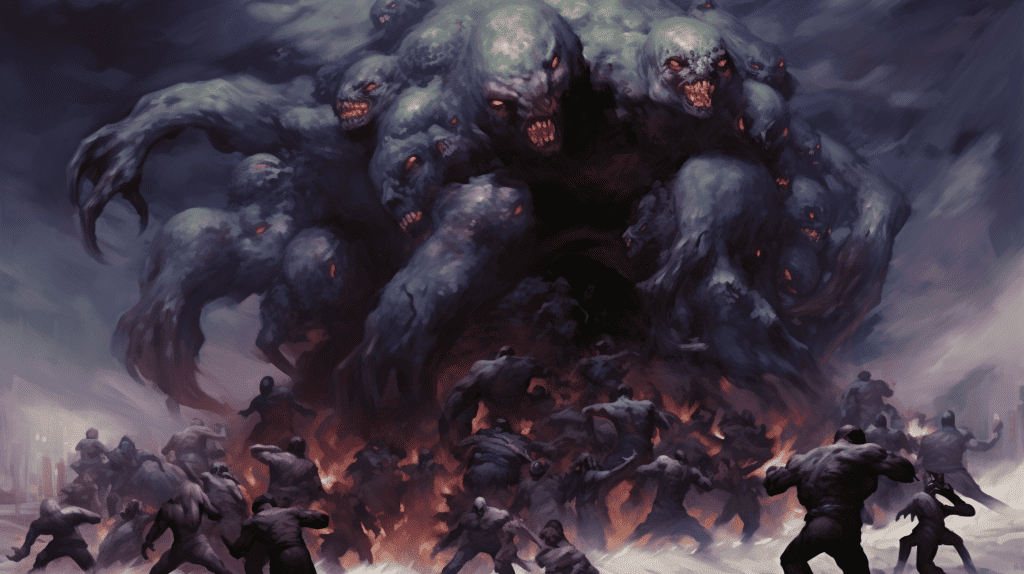
These creatures derive from Greek mythology. The word “hecaton” means hundred and “cheir” arms, making it the “Hundred-Hander”.
The hecatoncheire has been presented in various ways throughout the different editions of the game. The evolution of the monster started as a towering swarm of 50 heads and 100 arms armed with swords but has, in later editions, been depicted as a four-armed giant.
The monster’s body resembles that of a large tree and moves by using a series of roots at its base.
Nevertheless, the hecatoncheire is incredibly rapid because of its bizarre amount of arms, allowing it to attack a myriad of times during a single round. While it’s wise to attack the hecatoncheire from afar to be out of reach for the swarm of swords, one should still expect the abomination to be able to counterattack.
Challengers will be put to the test during this encounter where you’ll have to dodge a barrage of sword attacks in melee range or avoid enormous stones as they’re thrown against you at a distance. To make the encounter even worse, they’re capable of rejuvenating wounds that aren’t caused by divine weapons.
Beholders (CR 13)
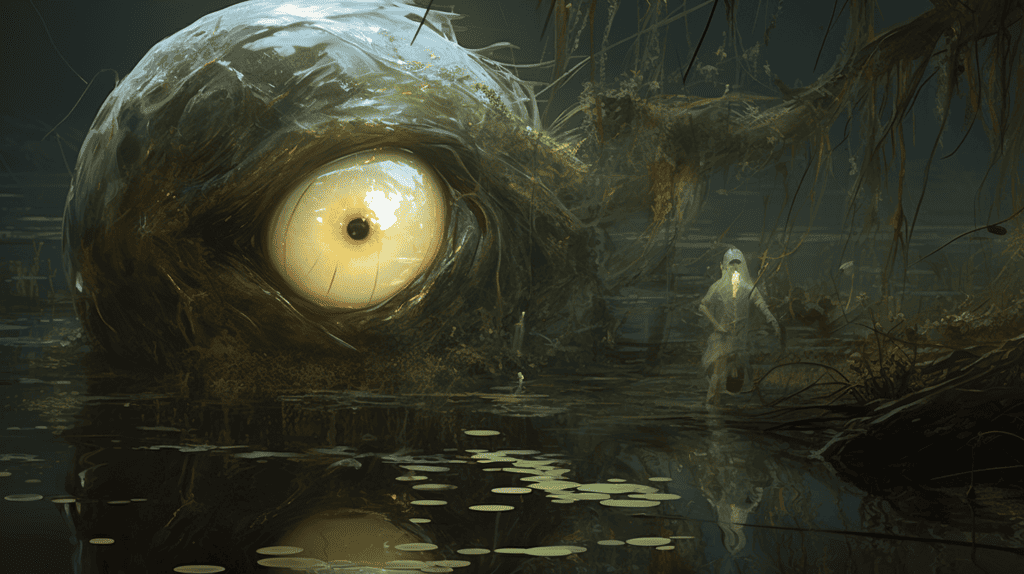
Depicted as a floating blob with one rather large eye, a mouth, and tentacles armed with multiple smaller eyes, the Beholder is an abomination you won’t forget. The creature may not look like much at first glance but their kin reign supreme over other beings and consider themselves superior to all other creatures.
Beholders are not the most versatile creatures when it comes to their arsenal. There are a few noteworthy attacks at their disposal – the first being a fearsome bite attack and the second being their trademark attack, the eye ray.
The eye ray is what gives the Beholder more layers and adds complexity to the encounter, as there are multiple variants of the eye ray that have different effects. Among the 10 variants, there are two that are deadlier than the others.
Also Check Out: The Best D&D Campaigns For Beginners
The death ray and the disintegration ray are both capable of depleting a character’s hit points in a single hit. Those who manage to avoid these rays might stand a chance against the floating eye monster.
Elder Brain (CR 14)

It comes as no surprise that a monstrosity called the Elder Brain has the ability to read thoughts and manipulate minds.
Portrayed as a giant floating brain in a see-through cover filled with harmful fluid, the Elder Brain has a truly monstrous appearance that matches its intentions.
As threatening and fatal an encounter with an Elder Brain can be, it’s made even worse by the fact that these creatures rarely go unguarded by their servants, the mind flayers.
Mind flayers are a highly intelligent ancient race that resides in the Underdark – a subterranean network of tunnels.
In their colony, the mind flayers are controlled by a hive mind, which acts as a repository for accumulated knowledge, memories, and intellect in the community.
This hive mind is the Elder Brain. With this in mind, you might understand why you won’t be able to attack an Elder Brain without having a swarm of mind flayers appear.
Purple Worm (CR 15)

Purple worms are enormous beasts capable of burrowing through solid rock. They’re famous for their insatiable hunger and immense size. Much like the sandworms in Dune, purple worms are able to sense vibrations in the ground and then quickly move toward the vibrations to devour whatever living thing they might find there.
The purple worm’s 80-foot-long body is covered in purple chitinous plates, and its enormous maws are capable of devouring a party member whole. It’s also armed with lines of razor-sharp teeth and at the end of its body sits a stinger that will incapacitate anyone who’s stung.
If you’re unable to levitate or move through the air, hiding from a purple worm is very unlikely. By creating a complex network of subterranean tunnels, the purple worm can move from one point to another with great haste.
Encountering a purple worm is a terrifying experience, their sheer strength and speed are enough to crush a human body, and their acidic digestive system will dissolve the toughest materials.
Purple worms are often found in underground caverns or deep within dungeons, where they often guard treasures or roam their habitat freely as apex predators.
Marilith (CR 16)

Depicted as some sort of reptile humans, Mariliths have a human female upper body while their lower body is that of a giant snake. Their upper body hosts six strong and quick arms wielding long swords, ready to throw a barrage of lethal strikes toward any foe who comes close.
They have connections in the Abyss, where they’ve acted as advisors to demonic nobility, trained demonic armies, and sometimes, climbed the ranks to the point where they’ve been considered demonic queens. Their intelligence and expertise in the field of warfare make them very valuable to those who seek to conquer the battlefields.
These aberrations are very quick to react, and anyone trying to surprise one will have to use their wits to not fail. The punishment, if caught, will be multiple strikes, by the aforementioned six arms – but there are more hazards in Marilith’s arsenal.
They have the ability to teleport to and from foes, making it incredibly hard to escape or kite the being from a distance. Its tail is used to knock players to the ground, incapacitating them.
Dragon Turtle (CR 17)

Deep down in the ocean roams one of the largest monsters in Dungeons and Dragons, the Dragon Turtle. A massive creature that combines characteristics from both dragons and turtles, the Dragon Turtle measures a staggering 70 feet in length and has the appearance of a massive turtle, but along its spine runs a row of jagged spines that resemble a dragon’s spine.
The Dragon Turtle is covered in scales that protect it from attacks, and as an aquatic creature, it can move speedily underwater. Unlike creatures in other domains, the Dragon Turtle isn’t evil in nature.
Instead, the Dragon Turtle has a neutral stand against others but keeps a strong territorial instinct to defend their territory against anyone who might be a threat.
This has made it possible for adventurers to concede part of their loot to the Dragon Turtle in exchange for safe passage through the turtle’s territory. Those who have refused
Death Knight (CR 17)

When a devoted paladin strays from his path and becomes corrupt without seeking to correct his wrongdoings before his death, the god he has pledged his life to will punish him by returning him to roam the earth as a Death Knight.
The former paladin can still find redemption for his sins – but most Death Knights fall into despair and become full of hatred against the god who cursed them. Instead, they devote their lives to spreading chaos and misery.
Having been powerful warriors in life, Death Knights wield lethal spells and abilities.
Death Knights are very interesting encounters in Dungeons and Dragons, as they’re not part of your run-of-the-mill creature pool. They aren’t killed by brute force or spells.
In fact, the Death Knight can’t be killed until the wicked actions the former paladin took during his living life have been redeemed.
You Might Also Like: The 20 Best Rare Magic Items in DnD
This will have the party investigating the Death Knight and the sins he performed with the aim of righting his wrongs so that he can return to rest peacefully ever after. Death Knights can be used for some pretty incredible storytelling, especially dark and tragic stories.
Nagpa (CR 17)
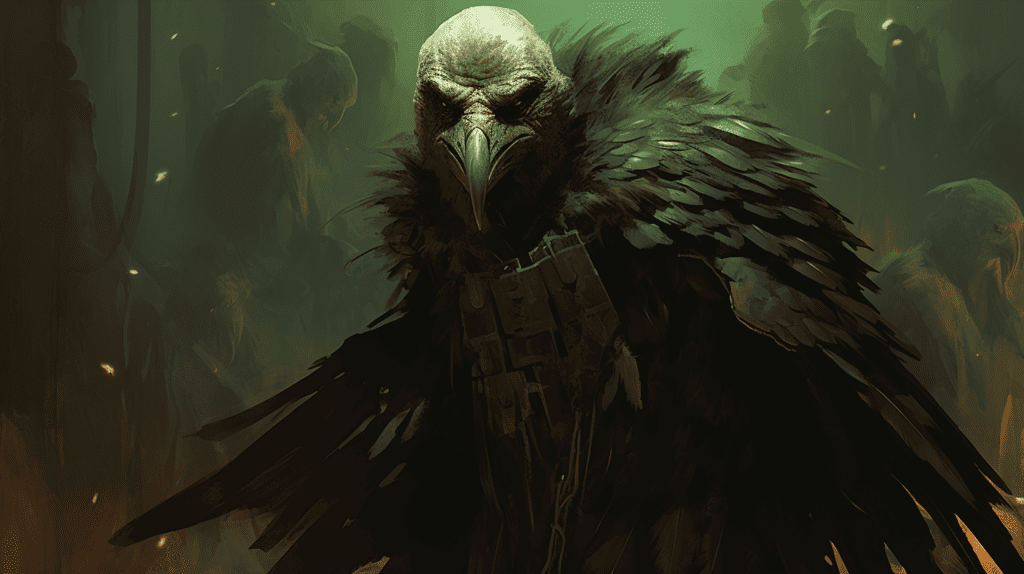
The Nagpa were once prominent elven mages devoted to serving the Raven Queen. When a pack of elven mages decided to plot against the queen to hinder her from completing a sacred ritual, the queen responded by cursing them.
The pack of mages was turned into Nagpas and banished to wander the material plane for the rest of their lives.
Their newly-acquired, somewhat hideous, form was that of a vulture-like humanoid with skeletal hands armed with Nagpa staffs, a staff with a bird-head. The Nagpa are unable to reproduce, and the race of the Nagpa will, therefore, one day come to an end when the last of their kin have fallen.
The Nagpa excels in the arts of arcane magic. They’re very selfish and reclusive, and do whatever they can to keep the knowledge of their curse from reaching the public.
Their kin does not require food or sleep in order to survive. They must, however, meditate for a big portion of the day in order to replenish their spells.
They’re not prone to aggression as long as their interests aren’t threatened. In fact, characters might end up receiving advice from a Nagpa if the creature isn’t provoked.
Dracolich (CR 17)

The Dracolich are remnants of dragons who’ve undergone rituals to become undead beasts. The ritual makes the once-dragon more powerful and gives it immunities and new abilities, such as the ability to control the undead. They’re soulless beings, as their souls are removed and spared in phylacteries when they become undead.
In battle, a Dracolich can frighten creatures and attack multiple times by using both their claws and maws. This combo leaves most characters with very little health left, if any.
Most who go into combat with a full-fledged Dracolich are either left on the battlefield or return with little to nothing left.
Additionally, the monstrosity has a powerful lightning breath that causes about 120 damage to anyone who’s struck by it. Defensively, the Dracolich can fly, making it easy for it to avoid melee attacks – in addition to this, it is also immune to multiple schools of spells.
Demilich (CR 18)
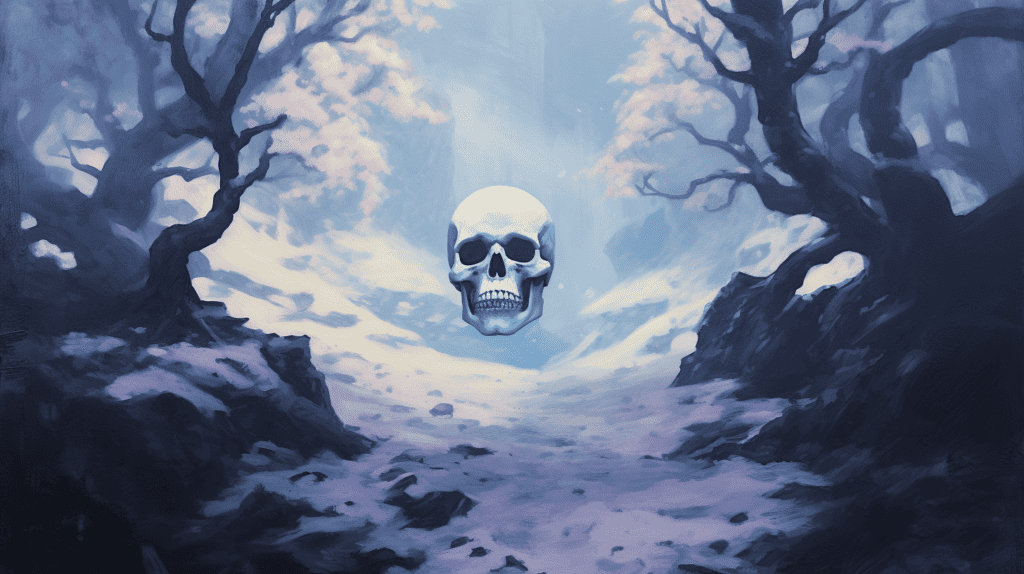
Prominent sorcerers and wizards who sought more power beyond death sometimes became liches, who were powerful undead casters. In pursuit of even more power, some liches would strive to become demiliches.
In order to become a demilich, a lich had to be separated from its body and then replace its body parts with soul gems. This required the lich to learn the art of creating soul gems.
In the process of becoming a demilich, the lich loses its extremities and torso. In the end, all that’s left is a floating skull that holds all of the soul gems created in the process. The soul gems could appear in other remaining parts of the liches body, but the most common form is a floating skull.
There’s no arguing why the Demilich has landed a spot on this list. The soul gems the skull holds are powerful enough to absorb a soul and the skull’s shriek is so horrifying that it leaves anyone exposed to it lifeless, with no possibility of resurrection.
Defensively, demiliches are immune to most attacks, making it incredibly hard to defeat one, should you encounter it. Only a small subset of rare weapons and powerful spells cause harm to the floating skull – so make sure you’re prepared if you want to stand a chance.
Oonga (CR 18)

The least conventional of the most dangerous creatures in Dungeons and Dragons might be Oonga. Created towards the end of the first edition of the game, the Oonga was introduced to allow players who had snowballed and become too powerful to still be challenged.
Depicted as an enormous version of King Kong in the scenario Isle of the Apes, the Oonga quickly became a household name as the towering creature was given incredible powers that not only matched those of some of the game’s strongest creatures but surpassed them.
Oonga has a lot of hit points, hits like a truck, is immune to mind control, and regenerates itself. Both dragons, demons, and giants were afraid of Oonga.
This is understandable, especially when you consider one of its most prominent attacks – its ability to pick a player up, squeeze him in its enormous grasp, drop him from wuthering heights, and stomp on whatever is left.
Balor (CR 19)

Despite their raw fury and desire for power, Balors are intelligent and persuading creatures. Through their ability to manipulate those around them, they worked their way up the ranks to command the legions of demons in Hell. To quench their thirst for power, Balors strive to take over the world by conquering it with their demonic armies.
Enveloped in an aura of darkness, Balors stand 12 feet tall and weigh up to 4500 pounds. Their grotesque and devilish body form is engulfed in flames. Much like pit fiends, Balors are armed with wings, venomous fangs, and razor-sharp claws.
But, as a symbol of their ability to command armies and battle fearlessly, Balors often dual-wield a flaming whip and a longsword charged with the power of storms.
However, even though their supreme ability to battle, Balors often favor scheming, plotting, and using their spells and long-range abilities to impact battles, rather than joining the legions on the frontlines.
The most powerful of the Balor’s abilities, Death Throes, is channeled when the Balor dies, causing the Balor’s flaming body to explode, sending massive pieces of burning flesh flying at high speeds. The explosion deals massive damage to the party and sets the surrounding area aflame.
Pit Fiend (CR 20)

In the unfathomable depths of the infernal realm, where chaos reigns and hellfire dances, a hierarchy or equilibrium must be upheld. The top of the demonic hierarchy of dominance is the pit fiend, who carves its path mercilessly through any imp or lesser demon foolish enough to impede its progress.
Known for their brutality, pit fiends have become both respected and feared in their domain. Should anyone who doesn’t belong there venture into Hell and encounter a pit fiend, they will have to use everything at their disposal to have a chance against the pit fiend.
Standing, 12-foot tall and weighing 800 pounds, the pit fiend is covered in scales, inflamed by their rage. The pit fiend’s back has two strong wings, giving the pit fiend a gargoyle-like appearance.
The pit fiend is a fearsome encounter, as it can use its maw, claws, tail, venomous teeth, and wings as weapons. If bitten, a character will suffer from a horrible disease known as devil chills.
Solar (CR 21)
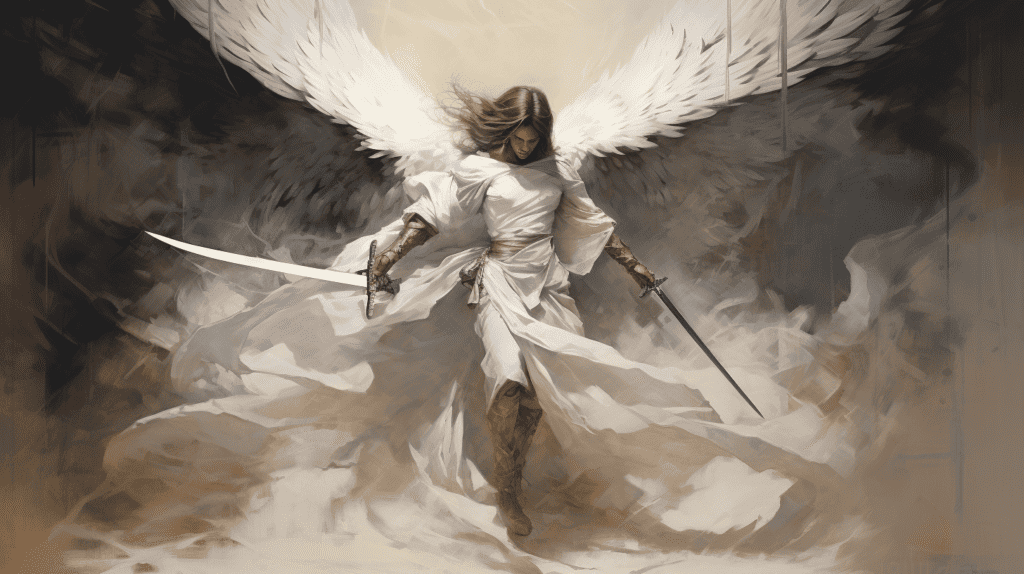
Solars, a type of archangel, are the most powerful of all angels and celestials in Dungeons and Dragons. To some, they’re considered to be godlike but the Solars don’t want worshippers of their own. Instead, they only want to serve the divine power that they’ve pledged their allegiance to.
Deep within the flaming hell holes in the Abyss, the demon lords themselves fear the day a Solar makes an appearance, as they’re exceedingly powerful beings whom Orcus himself would stand little chance against.
Few beings are strong enough to challenge Solars for power, as the Solars have a vast arsenal of powerful attacks and spells. Armed with a greatsword that can slash through creatures with ease and even fight on its own while the Solar shoots fiery arrows, a Solar can face armies of feeble creatures without harm.
Dealing damage to one is no piece of cake either, as they’re highly resistant to magic and weapons.
Elder Titan (CR 21)

Among all of the giants in Dungeons and Dragons, the elder titans are colossal in comparison to the rest of their kin. Their immense size and strength make them an unstoppable force to be reckoned with.
Anything in their path will be left in ruins as they rummage through cities armed with gigantic hammers or javelins.
Don’t let their size and exceptional strength fool you, they’re also extremely intelligent beings and skilled spellcasters. Some titans are even capable of becoming invisible and levitating. This mixture of cosmic size, brute force, and vast intelligence makes the elder titan extremely dangerous.
Molydeus (CR 21)
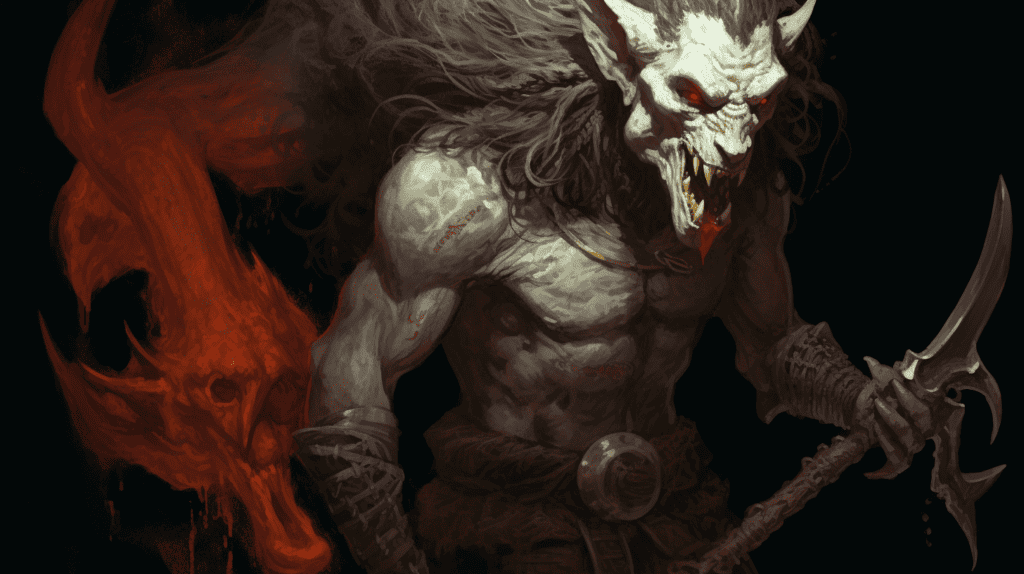
Deep within the Abyss, Molydeus serves as one of the demon lord’s most prominent and powerful servants, and are even considered superior to balors.
Depicted as a demon with a goat head and a snake attached to its back, the Molydeus is incredibly dangerous and masters a plethora of fearsome attacks that will leave few characters intact.
As the demon lords’ servants, the Molydeus are expected to and capable of withstanding the attacks of an entire party single-handedly without the help of their lords or other feeble creatures.
Standing about 4 meters tall and weighing 650~ kilograms, the demon is covered in red skin, and equipped with a set of lethal clawed hands.
In addition to its claws, the Molydeus often carry a unique demonic weapon linked to them. While the weapon could vary depending on the lord they served, it’s more often than not a demonic greataxe. These weapons are deadly but will dissolve when the Molydeus is slain to ensure no one else can harness its power.
Molydeus have plenty of magic abilities, a lot of resistance against different schools of magic, a set of powerful attacks, and a couple of legendary actions.
These attributes cause problems for any foes by themselves, but when combined, they offer characters the possibility to meet with something they’ve never seen before.
Empyrean (CR 21)

Empyreans are tall and graceful beings who never age and always maintain their beauty. Their titan-like appearance is the shell of an inside that’s controlled by strong emotions. So strong that the Empyrean can physically alter their surroundings based on their mood.
As for some of the other creatures on this list, Empyreans aren’t aligned to do evil. In fact, they’re kind and well-meaning – or at least most of them.
Read More: 10 Ways To Make DnD Fun For Beginners
Some Empyreans stray too far from their path and become corrupted or cursed by an evil deity. They’re then banished from their home plane and sent to the Prime Material Plane. Encountering an evil Empyrean is a completely different experience.
From ground-shaking attacks to powerful spells, they’re a force to be reckoned with. With an armor class of 22 and 313 hit points at their disposal, their foes are in for a long fight.
Zaratan (CR 22)
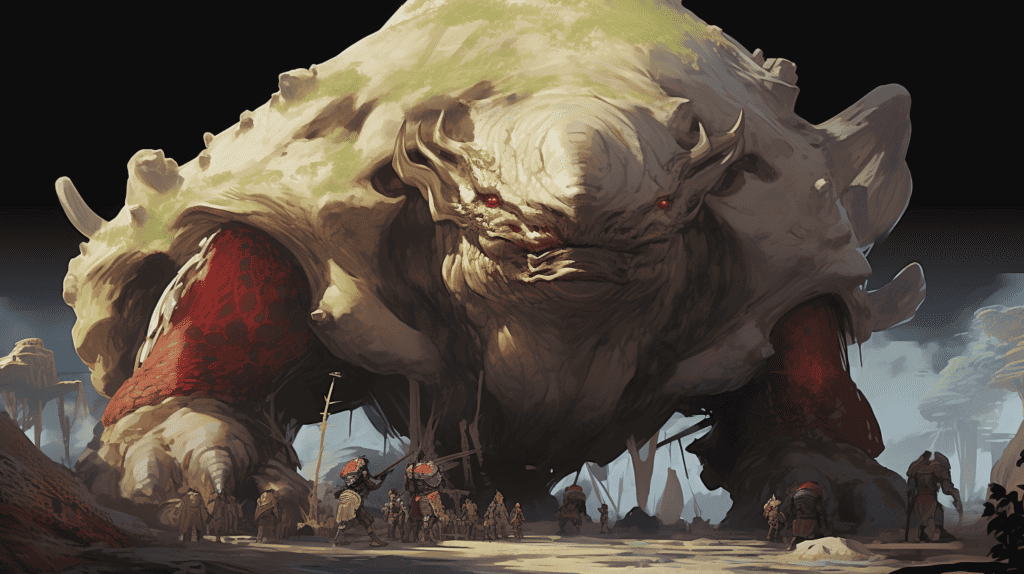
The Zaratan, a turtle-like creature with a shell measuring hundreds of feet in diameter, is a beast to be reckoned with. Their metabolism allows them to live for thousands of years, during which sediment and plants will start growing on their shells, creating a sort of ecosystem on the monster’s back.
When submerged halfway, a Zaratan could be mistaken for an island because of the vegetation on their shells. They’re not evil, but they’re not good either. They’re just beings who you don’t want to get on the wrong side of.
These creatures are extremely dangerous and will strike back with the force of an army at anyone who’s provoking them or hindering their march forward. They do, however, spend most of their time sleeping inside their shell and reflexively swallow anything that gets close to the opening during their hibernation.
Fighting one is difficult, as the Zaratan’s movement creates dangerous shockwaves that the party must withstand. When damaged, the turtle will retract its body into the impenetrable shell on its back and wait until it has regenerated.
Sometimes, the Zaratan will go into a deep slumber which can last for decades once retracted. The encounter is, as you can imagine, difficult to navigate.
Kraken (CR 23)

A creature that can control the oceans wields tremendous power over those who seek to traverse it. By manipulating currents and the weather, Kraken can create the perfect opportunity to strike and sink both lonesome ships and entire fleets.
These colossal monstrosities can swallow foes whole. Anyone who survives being swallowed can fight the monster from within. Fighting a Kraken is no joke, even for the most stacked of parties, as the Kraken bears high stats and deals lethal damage with its tentacles.
Even though the Kraken is known for being a horrendous sea creature, it is by no means bound to the aquatic domain and can breathe out of the water. The deep trenches of the sea are its primary habitat, though.
Good luck fighting one. Hopefully, it doesn’t regenerate its tentacles once you’ve sliced them off or spew a cloud of black ink your way.
Ancient Red Dragon (24)
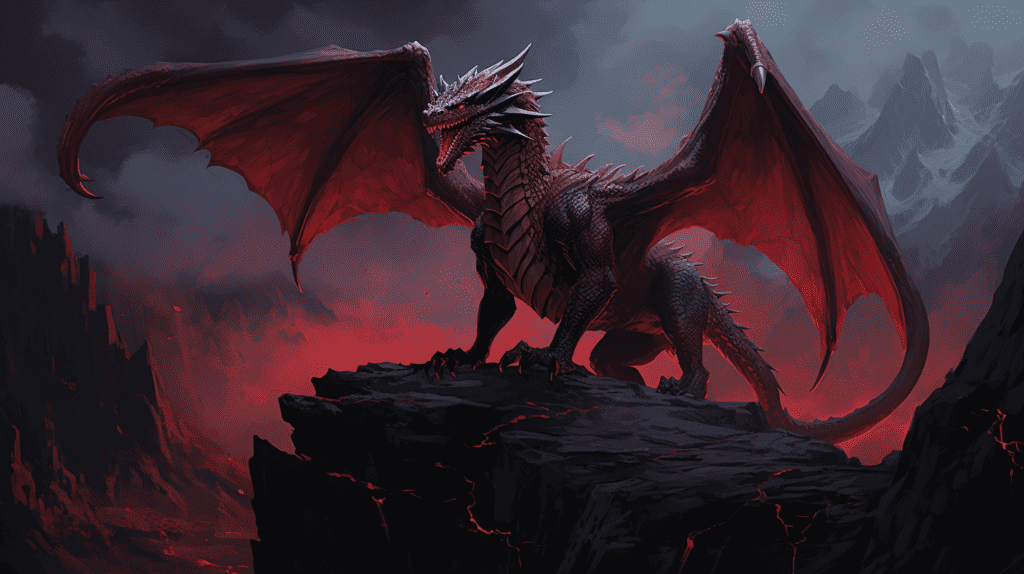
Challenging an ancient dragon, regardless of which one it is, isn’t for the faint of heart, as they’re some of the most dangerous creatures, and a fight with any of them is an obstacle that will drain or defeat even the most prepared party.
Among these unstoppable forces, the red dragon is known for being one of the strongest, only triumphed by Tiamat. It’s very evil, self-centered, and extremely protective of its treasures.
The red dragon is no tactician, unlike many other foes on this list. Instead, it snaps and goes berserk without any forethought. Their power and cruelty make them incredibly dangerous even without a plan. Having a monster of this size go into a blackout rage and act unpredictably will shock anyone.
During an encounter with the red dragon, the party can expect it to cast a fire breath that will either kill or severely damage the party, and a wing attack that can render characters incapacitated. In addition to their strong attacks, they’ve got a boatload of hit points and a high armor class.
Primus (CR 25)

Known as the lord of the Modrons, Primus is the supreme power that leads his race of lawfully aligned beings who inhabit Mechanus, the Plane of Law.
The fact that ending up on the wrong side of the law could lead to an encounter with Primus will have creatures reconsider their plans, as Primus has enough force to incapacitate most woes.
While Primus is no god, he comes very close. His entire demeanor conveys a sense of law, order, precision, and perfection.
Primus emerges from a pillar of energy, his upper body is that of a humanoid while his lower body is a column of spiral energies. His appearance is surrounded by a radiant aura that symbols his almost divine power and superiority.
As a talented spellcaster that rarely relies on his magic abilities, Primus has gathered enough brute force to use his melee attacks to fend off attackers who dare approach him.
Marut (CR 25)
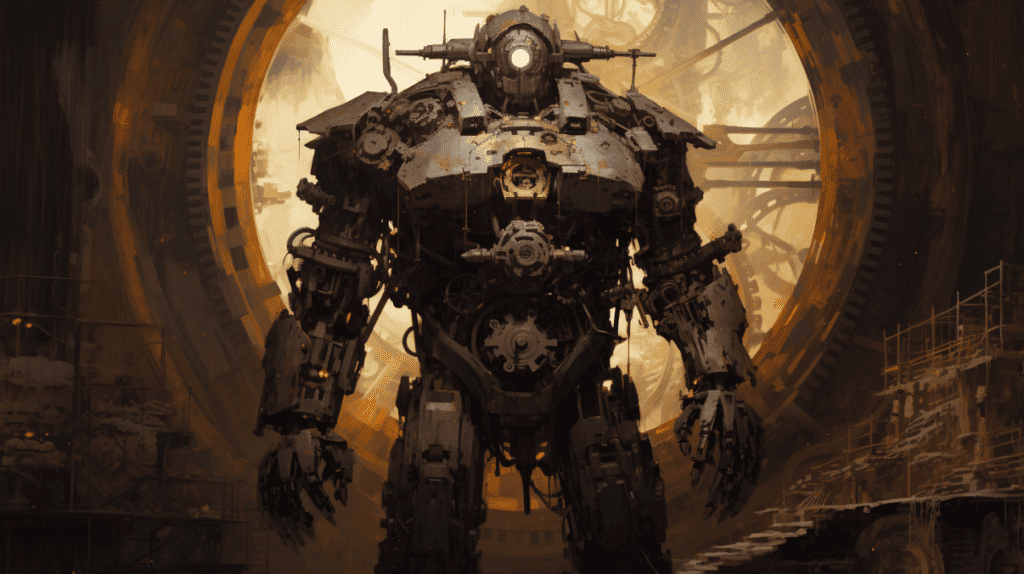
The Maruts were created by Mystra to enforce the fundamental laws of the universe. Primarily, finding those who’ve found ways of denying or cheating death and ensuring they’re punished for it.
As enforcers of contracts throughout the Multiverse, Maruts have been given significant strength and power to be able to carry out the tasks they’ve been given. Maruts care about little except their duties given by the deities who they serve.
Maruts are mostly found on their home plane of the Mechanus, where clockwork creatures roam. They’re depicted as large mech-titans, humanoid in form but made of mechanical components, and wield no weapons but carry out lethal damage through brute force.
Once these colossal mechanical enforcers have spotted their target, they march toward it without doubt or pause and continue to pursue until the target has been eliminated and the task has been completed.
Maruts mainly rely on their fists of lightning and thunder to deal damage but they’re also able to channel bursts of arcane energy from their chest, which both damages and stuns enemies.
The Marut’s left fist, the thunder fist, emits a huge thunderclap that can deafen opponents for up to a minute when it strikes. The right one, the lightning fist, strikes with a great flash of electricity that can blind a foe for the same amount of time.
Demogorgon (CR 26)
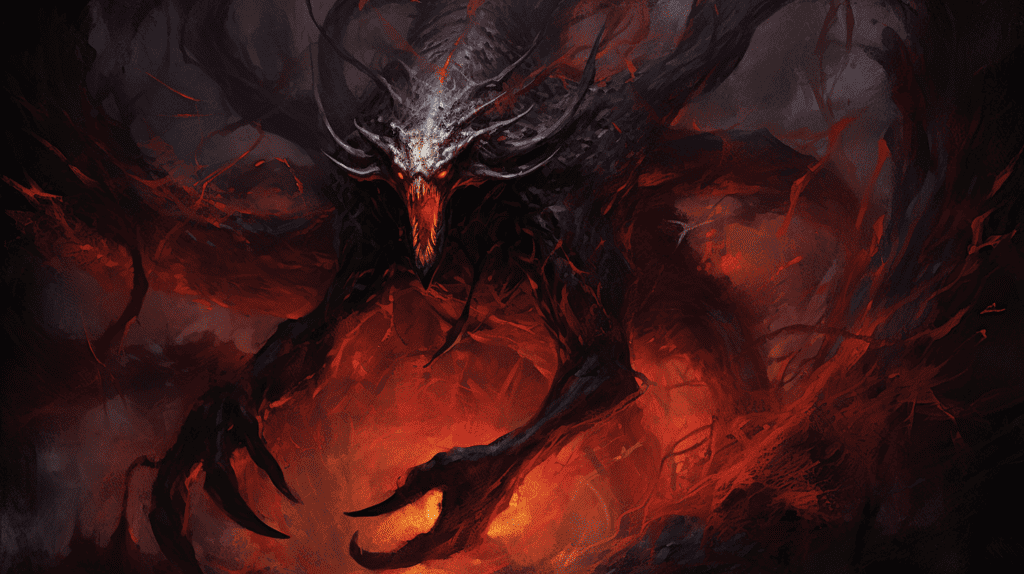
The powerful demon prince, Demogorgon, is one of the most famous and feared villains in the game’s lore. He lived on the 88th layer of the Abyss, known as Gaping Maw, where he raised a palace known as Abysm, which consisted of two towers connected by a bridge at the top.
He is worshiped as a god by many other evil creatures. His two heads create a duality that plagues him as there’s an ongoing internal conflict between the two heads. Demogorgon is known for his cruelty, as he has a strong desire to spread chaos and destruction throughout the Abyss.
Demogorgon can be one of the most challenging encounters in the game to defeat, even for high-level players. His attacks deal a great amount of damage and his powerful abilities and magic can leave characters with little-to-no hp left. But as with most things in Dungeons and Dragons, the encounter can be made harder or easier.
Adding other creatures by the Demogorgon’s side is a surefire way of making the encounter harder. Another is to fight him in his own favorite domain – water.
Orcus (CR 26)
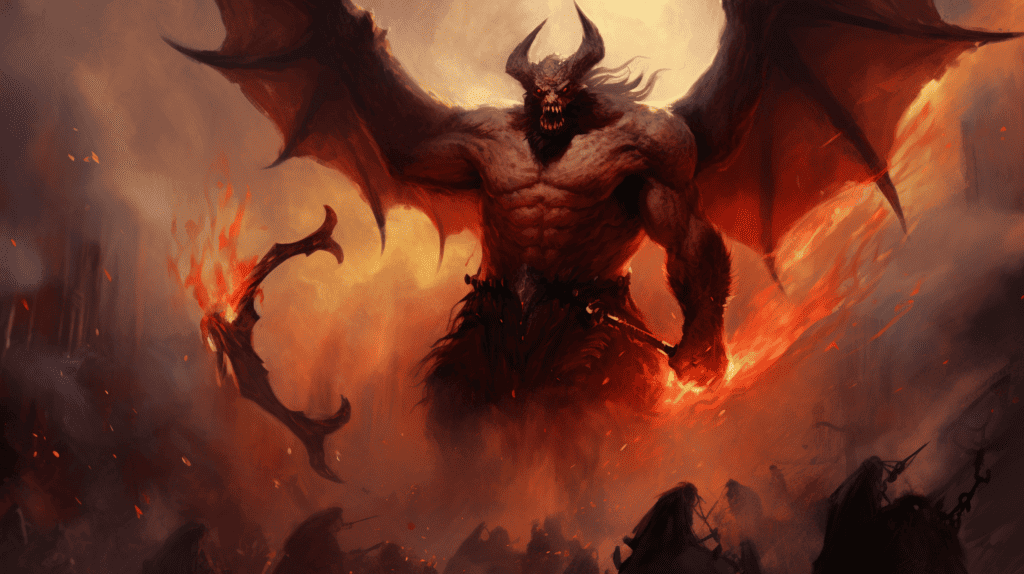
The Demon Prince of the Undead, Orcus, was once a powerful and wicked spellcaster on the mortal plane. His actions during life forced him to an afterlife in the Abyss, where he worked his way from the bottom to the top. The climb took thousands of years, during which he challenged many other demon lords for power.
Once at the top, Orcus showed very little compassion for the minions who served him. Those who serve under his rule and prove powerful and willing to continue his mission of spreading chaos are given a piece of his power, but they’re bound to him. Orcus’s goal is to create a gigantic necropolis under his command.
Vecna – Lich (CR 26)
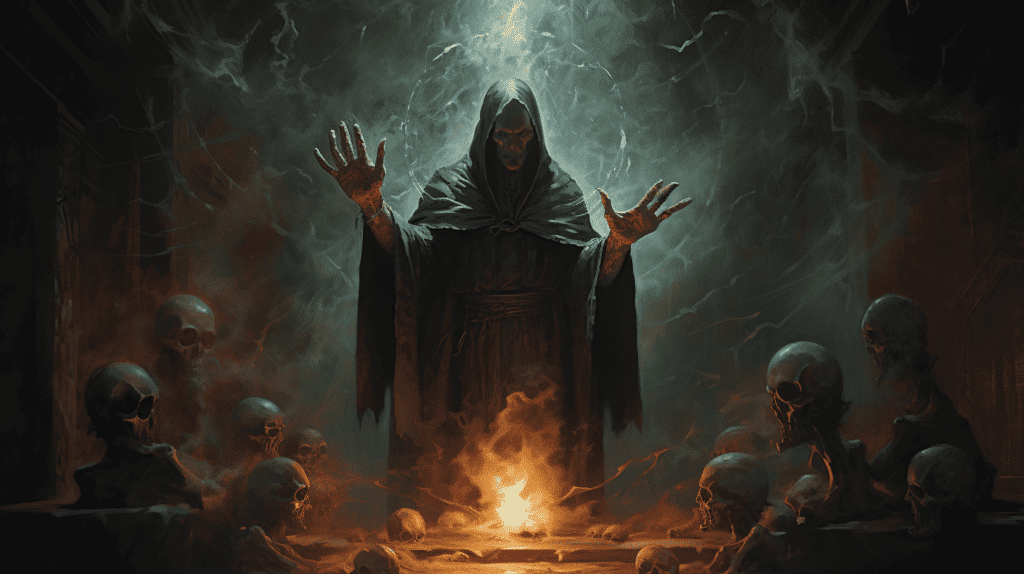
Vecna, popularized by Stranger Things, is a former human king turned lich who was betrayed by one of his closest servants. Vecna isn’t bound to any single domain but roams all over the multiverse with the intent to bring destruction and gain dominion over other beings.
One of Vecna’s methods to gain sovereignty is to manipulate and expose others’ secrets. According to Vecna, every being holds a single secret that, when unearthed, gives others control of that being. Thanks to his incredibly keen perception, he doesn’t miss anything.
Vecna’s foes are usually met with a myriad of different powerful attacks, as he himself harbors tremendous powers. Among the least forgiving of his abilities, you’ll find horrible ways of altering reality and paralyzing his targets with his touch.
Tiamat (CR 30)

Dragon goddess of greed, queen of evil dragons, sister of Bahamut, and servant of gods Bane and Asmodeus – Tiamat isn’t just the mightiest of dragons, but one of the most powerful creatures in Dungeons and Dragons altogether.
Tiamat is depicted as a dragon with multiple heads, one for each color of the chromatic dragons (red, blue, black, and green).
Each head is capable of acting independently of the other heads and carries the powers of the chromatic dragon its color represents. During combat, these heads will cooperate and cast breath-like spells associated with their species.
Tiamat has the ability to claw and kick her victims with enormous force, but mostly when she’s airborne as the sheer size of her body makes it hard to do while standing. At the end of Tiamat’s tail sits a stinger that injects victims who are stung with a fatal venom.
This mixture of abilities in combination with Tiamat’s deity status and stats turn this dragon into a powerhouse few can triumph.
Tarrasque (CR 30)

Towering over most other creatures in Dungeons and Dragons, the Tarrasque has probably become the most infamous monster in the game, known for its hunger for destruction and ability to wreak havoc on everything it sets its gaze on. During a rampage, anything standing in the Tarrasque’s way will be left devastated.
Get Into DnD: The Complete Guide On How To Start Playing D&D
Everything about the creature is designed to be a symbol of brute force. Its appearance is much like that of a dinosaur with spikes along its back. It stands fifty feet tall and seventy feet wide, with an enormous maw capable of swallowing enemies whole.
Because of its sheer strength, the Tarrasque’s attacks are primarily hard-hitting melee attacks. In addition to its devastating attacks, the monster has a reflective carapace, which can redirect spells back toward the caster.
